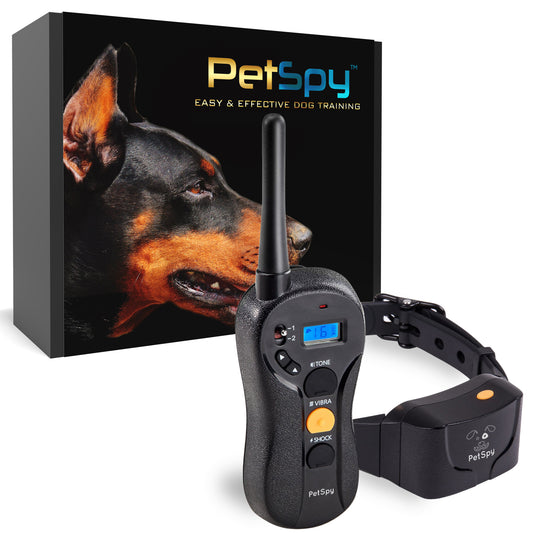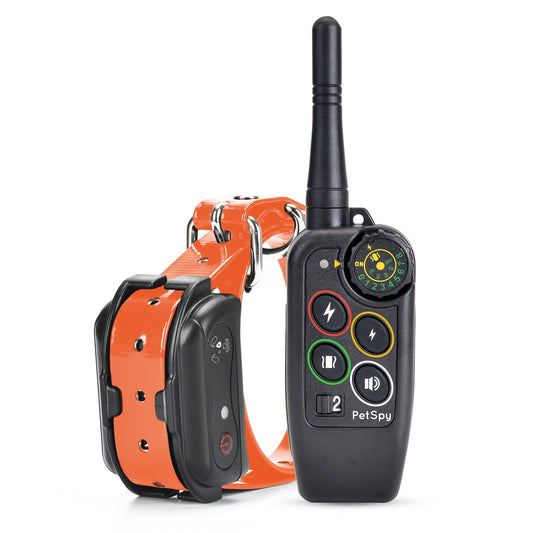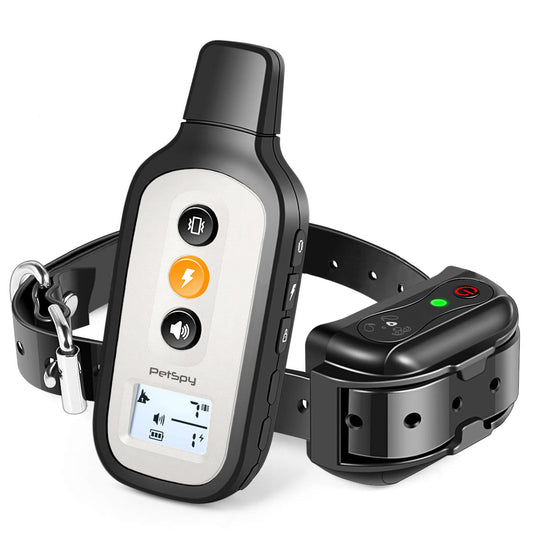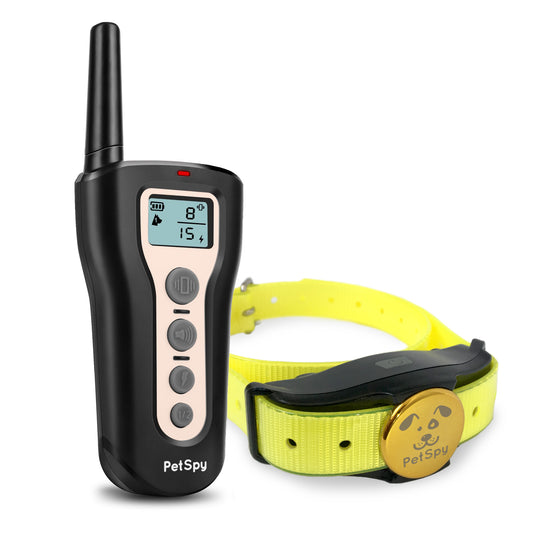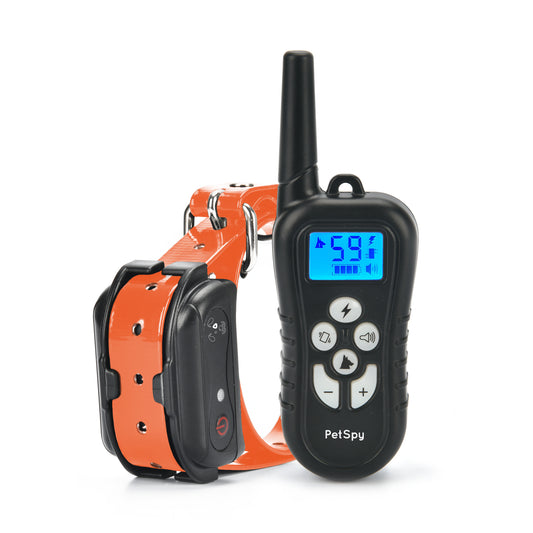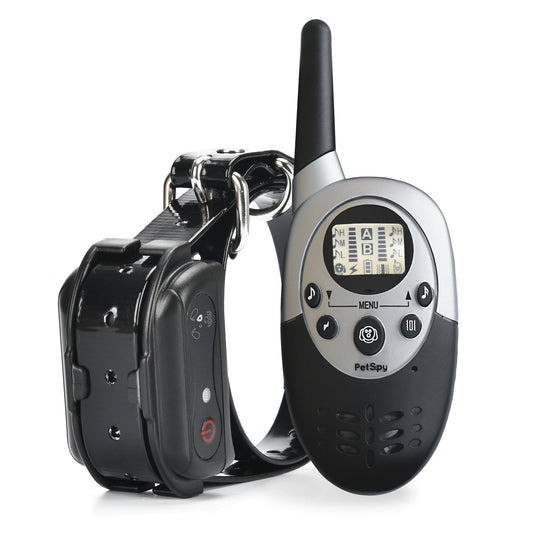Collection: Dog Shock Collar
Make dog's training easier
-
PetSpy Shock Collar - P620 Pro PetSpy Collar Field Trainer
4.748287054 / 5.0
(2773) 2773 total reviews
Regular price $69.99 USDRegular priceUnit price / per$99.99 USDSale price $69.99 USDSale -
M686 Remote Trainer - PetSpy Collar Perfect for Hunting
4.619186047 / 5.0
(688) 688 total reviews
Regular price $69.99 USDRegular priceUnit price / per$99.99 USDSale price $69.99 USDSale -
XPro Remote Dog Training Collar
5.0 / 5.0
(8) 8 total reviews
Regular price $49.99 USDRegular priceUnit price / per -
Shock collar for dogs remote training - P320 Perfect for Field Training
4.909090909 / 5.0
(11) 11 total reviews
Regular price From $49.99 USDRegular priceUnit price / per -
M919-1 Premium Shock Collar
4.7 / 5.0
(110) 110 total reviews
Regular price $59.99 USDRegular priceUnit price / per -
Dog command collar: M86-1 Advanced training collar for dogs
4.666666667 / 5.0
(12) 12 total reviews
Regular price $45.99 USDRegular priceUnit price / per$75.00 USDSale price $45.99 USDSale -
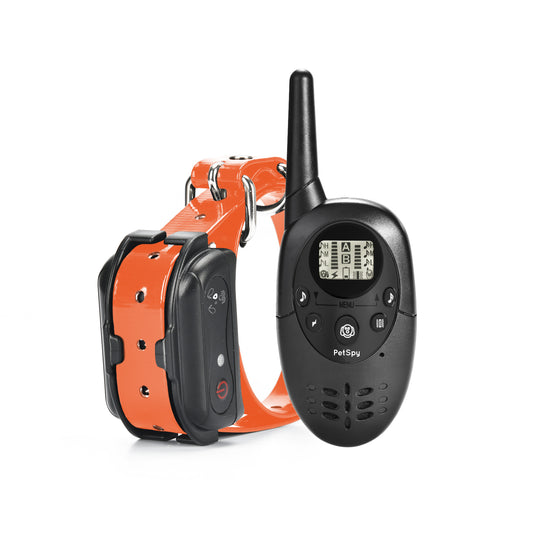 Sold out
Sold outM86N Advanced Dog Training Collar
4.75 / 5.0
(8) 8 total reviews
Regular price $49.99 USDRegular priceUnit price / per
What is a dog shock collar
A shock collar for dogs is an electronic device used to train and correct unwanted behaviors in dogs. The dog shock collar was invented in the 1960s by Richard Peifer, a famous animal behaviorist, as a part of his research on training hunting dogs. Peifer's innovative technology and new approach to dog training aimed to provide a more efficient method of behavior modification compared to traditional techniques. The shock collar for dogs works by delivering an electric shock to the dog's neck through a set of two small electrodes. This shock can be adjusted in intensity and duration, depending on the specific training requirements. The dog shock collar with remote is often controlled remotely, enabling the handler to administer the correction from a distance. The remote control shock collar offers a higher level of control and precision in training, which can be crucial for achieving desired results. One of the most significant advantages of the shock collar for dogs is its ability to provide consistent and timely corrections. This consistency is critical for effective learning, as it allows the dog to associate the undesirable behavior with the discomfort caused by the shock. The best dog shock collar dogs can benefit from are those that come with a range of stimulation levels, safety features, and alternative modes such as vibration and sound, ensuring a more humane and tailored training experience. Experts in the field of dog training have differing opinions on the use of shock collar for dogs. Some argue that the dog shock collar is a valuable tool when used responsibly and in conjunction with positive reinforcement techniques. They believe that the best shock collar for dogs can be effective in addressing severe behavioral issues, such as aggression or excessive barking, which may not be manageable through other training methods. On the other hand, some experts argue that the use of electric shock collar for dogs can cause stress, fear, or anxiety in the dog. They advocate for more positive, reward-based training methods and consider the dog shock collar to be a last resort, only to be used under the guidance of a professional trainer. The shock collar for dogs was developed as an innovative technology to improve dog training efficiency. When used correctly, the shock collar with remote can be an effective tool for behavior modification. However, the device remains controversial among experts, and it is essential to consider the welfare of the dog and be conscious when using a shock collar for dogs.
Dog shock collar and it's key features
The shock collar for dogs is an innovative method of dog training that offers several key features and benefits. The primary function of a dog shock collar is to deliver an electric shock to the dog's neck to correct unwanted behaviors or reinforce obedience commands. The following are the main characteristics, specifications, and technical capabilities of the dog shock collar. Remote control: A dog shock collar with remote allows the handler to administer the correction from a distance, providing greater control during training. The shock collar for dogs is particularly useful for off-leash training and working with dogs at a distance. Adjustable stimulation levels: The dog shock collar comes with multiple stimulation levels, allowing the handler to customize the intensity of the shock based on the dog's size, temperament, and training requirements. The best shock collar for dogs offers a wide range of stimulation levels to ensure a tailored and humane training experience. Alternative modes: Some shock collar for dogs models offer alternative modes such as vibration and sound, providing a more humane and less aversive method of training. These additional modes make the dog shock collar more versatile and effective in addressing a broader range of behavioral issues. Waterproof and durable: A good shock collar for dogs should be waterproof and built to withstand rough outdoor conditions, ensuring that the collar remains functional during various training scenarios and in different weather conditions. Safety features: The dog shock training collar should include safety features such as automatic shut-off to prevent continuous shocks and the risk of injury to the dog. These safety features help ensure that the dog training collars shock does not cause undue harm or stress to the animal. The innovative method of dog training using a shock collar for dogs can be highly effective when used responsibly and in conjunction with positive reinforcement techniques. The dog shock collar with remote allows for precise and timely corrections, which are crucial for effective learning. By using a shock training collar, dog owners can address various behavioral issues and achieve better obedience from their pets. The dog shock collar offers several key features and benefits, such as remote control, adjustable stimulation levels, alternative modes, durability, and safety features. When used correctly, this innovative method of dog training can yield significant results and help dog owners establish better control and communication with their pets.
Dog shock collar: How to use it
To effectively use a shock collar for dogs in training, it is essential to follow a step-by-step process to ensure the dog's safety and well-being. Here is a detailed explanation of how to use a dog shock collar. Choose the right collar: Select the best shock collar for dogs can comfortably wear and ensure it offers adjustable stimulation levels, alternative modes, and safety features. A good shock collar for dogs should be tailored to your dog's size, temperament, and training needs. Fit the collar: Properly fit the shock collar for dogs around the dog's neck, ensuring the electrodes make contact with the skin without causing discomfort. The dog shock collar should be snug but not too tight, allowing you to fit two fingers between the collar and the dog's neck. Familiarize yourself with the remote: Study the dog shock collar with remote to understand its functions and settings. The shock collar for dogs typically has buttons to control the shock intensity, duration, and alternative modes such as vibration and sound. Begin training with low stimulation levels: Start the training process using the dog shock collar on the lowest stimulation level to gauge your dog's response. Gradually increase the intensity as needed but avoid causing unnecessary discomfort. Timing is crucial: When using the dog shock training collar, ensure the correction is administered at the exact moment the unwanted behavior occurs. This helps the dog associate the behavior with the discomfort from the shock, making the dog shock collar more effective. Combine with positive reinforcement: While using the dog shock collar, incorporate positive reinforcement techniques such as praise and treats to reward desirable behavior. This balanced approach encourages the dog to learn more quickly and creates a positive training experience. Monitor progress: Keep track of your dog's progress with the dog shock collar with remote and adjust the intensity or mode as necessary. As your dog becomes more responsive, you may be able to transition to using the vibration or sound modes instead of the electric shock. Consult a professional if needed: If you are unsure about using a dog shock collar or your dog does not respond well to the training, consult a professional dog trainer for guidance and support. The mechanism of action of a shock collar for dogs involves delivering an electric shock to the dog's neck to interrupt and correct unwanted behaviors. The timely and consistent application of the shock helps the dog associate the behavior with the discomfort, thus modifying the behavior over time. When used correctly, a dog shock collar can be an effective tool in reinforcing obedience commands and addressing various behavioral issues.
Dog shock collar VS standard collar
In arguing for the effectiveness of a shock collar for dogs in comparison to bark collars and regular collars, it is essential to focus on unique advantages that have not been previously discussed. Consistency in training: A key aspect of successful dog training is consistency, and a dog shock collar can help achieve that. Unlike regular collars, which rely on the owner's ability to correct behaviors physically, a shock collar for dog delivers a consistent stimulus, ensuring that the dog receives the same correction every time the undesired behavior occurs. Bark collars are limited to addressing barking behavior, whereas a dog shock collar can consistently correct a wider range of behaviors. Reduced owner frustration: Owners using regular collars may become frustrated when their physical corrections are not effective, leading to possible resentment or tension in the relationship between owner and dog. The use of a dog shock collar with remote can help alleviate this frustration by providing a means for the owner to correct behavior without resorting to physical confrontation. This can lead to a more positive training experience and a stronger bond between owner and dog. Long-term behavior modification: While bark collars are designed to address barking issues specifically, a shock collar for dogs can provide more comprehensive and long-lasting behavior modification. The electric shock collar for dogs can be used to address a variety of issues, which, when combined with positive reinforcement, can result in lasting behavioral changes, making it a more effective tool for long-term training compared to bark collars or regular collars. Customization for individual dogs: Every dog has unique training needs and sensitivities. A dog shock collar with remote allows for customization, giving the owner the ability to tailor the training experience to the dog's specific requirements. This level of personalization is not achievable with bark collars, which typically have preset stimulation levels, or regular collars, which lack any form of electronic correction. Greater control in challenging situations: In certain situations, such as dealing with aggressive dogs or those with a high prey drive, a dog shock collar can offer more control than bark collars or regular collars. The ability to remotely administer a correction using a shock collar for dogs can help the owner manage their dog in potentially dangerous or challenging situations, promoting safety and control that is not possible with other collar types. The shock collar for dogs offers unique advantages over bark collars and regular collars, such as consistency in training, reduced owner frustration, long-term behavior modification, customization for individual dogs, and greater control in challenging situations. These factors demonstrate that a dog shock collar can be a more effective and useful tool for both the dog and the owner in addressing various training goals and behavioral issues.

